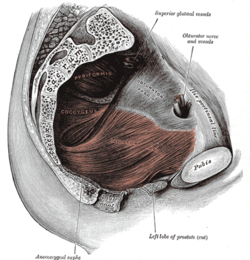The coccygeus muscle or ischiococcygeus is a muscle of the pelvic floor located posterior to levator ani and anterior to the sacrospinous ligament.
| Coccygeus muscle | |
|---|---|
 Left levator ani from within. | |
| Details | |
| Origin | Sacrospinous ligament and ischial spine |
| Insertion | Lateral margin of coccyx and related border of sacrum |
| Nerve | Pudendal nerve; sacral nerves: S4, S5[1] or S3-S4[2] |
| Actions | Pulls coccyx forward after defecation, closing in the back part of the outlet of the pelvis |
| Identifiers | |
| Latin | musculus coccygeus |
| TA98 | A04.5.04.011 |
| TA2 | 2412 |
| FMA | 19088 |
| Anatomical terms of muscle | |
Structure
The coccygeus muscle is posterior to levator ani and anterior to the sacrospinous ligament in the pelvic floor. It is a triangular plane of muscular and tendinous fibers. It arises by its apex from the spine of the ischium and sacrospinous ligament.[3][4] It is inserted by its base into the margin of the coccyx and into the side of the lowest piece of the sacrum.[3][4]
In combination with the levator ani, it forms the pelvic diaphragm.[5]
The pudendal nerve runs between the coccygeus muscle and the piriformis muscle, superficial to the coccygeus muscle.[6]
Nerve supply
The coccygeus muscle is innervated by the pudendal nerve, which runs between it and the piriformis muscle.[7]
Function
The coccygeus muscle assists the levator ani and piriformis muscle in closing in the back part of the outlet of the pelvis.[8] This helps to support the vagina in women, and the other pelvic organs.[8]
See also
References
External links
Wikiwand in your browser!
Seamless Wikipedia browsing. On steroids.
Every time you click a link to Wikipedia, Wiktionary or Wikiquote in your browser's search results, it will show the modern Wikiwand interface.
Wikiwand extension is a five stars, simple, with minimum permission required to keep your browsing private, safe and transparent.
